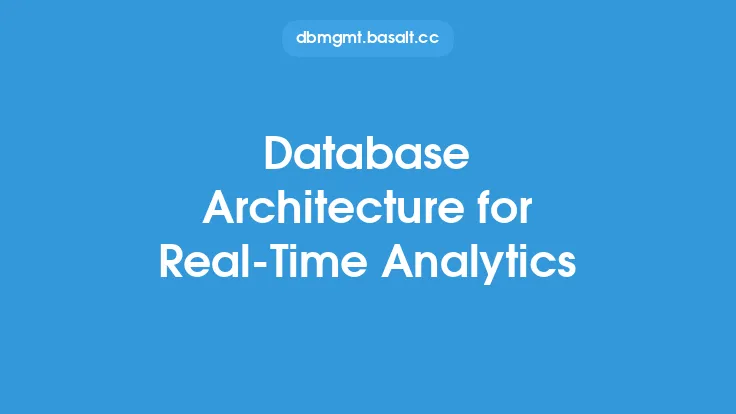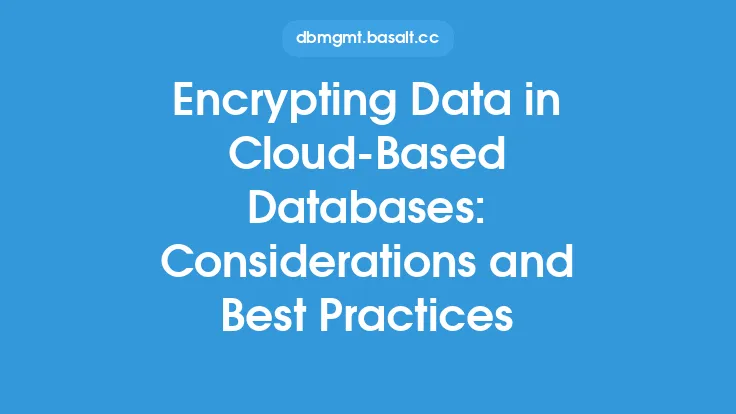Cloud-based database architecture refers to the design and structure of a database system that is hosted and managed on a cloud computing platform. This type of architecture has become increasingly popular in recent years due to its scalability, flexibility, and cost-effectiveness. In a cloud-based database architecture, the database is deployed on a cloud provider's infrastructure, such as Amazon Web Services (AWS), Microsoft Azure, or Google Cloud Platform (GCP), and is accessed through the internet.
Introduction to Cloud-Based Database Architecture
Cloud-based database architecture is designed to take advantage of the cloud's scalability and on-demand resources. This allows businesses to quickly scale up or down to meet changing demands, without having to worry about the underlying infrastructure. Cloud-based databases can be easily provisioned and de-provisioned, reducing the need for upfront capital expenditures and minimizing the risk of over-provisioning or under-provisioning. Additionally, cloud-based databases can be easily integrated with other cloud-based services, such as analytics and machine learning platforms, to provide a comprehensive data management solution.
Characteristics of Cloud-Based Database Architecture
Cloud-based database architecture has several key characteristics that distinguish it from traditional on-premises database architecture. These include:
- Scalability: Cloud-based databases can be easily scaled up or down to meet changing demands, without having to worry about the underlying infrastructure.
- On-demand resources: Cloud-based databases can be provisioned and de-provisioned on-demand, reducing the need for upfront capital expenditures and minimizing the risk of over-provisioning or under-provisioning.
- Multi-tenancy: Cloud-based databases can be designed to support multiple tenants, each with their own dedicated database instance, while still sharing the same underlying infrastructure.
- High availability: Cloud-based databases can be designed to provide high availability, with automatic failover and redundancy built-in to ensure minimal downtime in the event of a failure.
- Security: Cloud-based databases can be designed to provide robust security features, such as encryption, access controls, and auditing, to protect sensitive data.
Types of Cloud-Based Database Architecture
There are several types of cloud-based database architecture, each with its own strengths and weaknesses. These include:
- Infrastructure as a Service (IaaS): In this model, the cloud provider supplies the underlying infrastructure, such as virtual machines and storage, and the customer is responsible for managing the database.
- Platform as a Service (PaaS): In this model, the cloud provider supplies the underlying infrastructure, as well as a managed database platform, and the customer is responsible for managing the database instance.
- Database as a Service (DBaaS): In this model, the cloud provider supplies a fully managed database service, including the underlying infrastructure, database platform, and database instance.
- Serverless database architecture: In this model, the cloud provider supplies a serverless database service, where the customer only pays for the resources used, and the cloud provider is responsible for managing the underlying infrastructure.
Benefits of Cloud-Based Database Architecture
Cloud-based database architecture has several benefits, including:
- Reduced costs: Cloud-based databases can reduce costs by eliminating the need for upfront capital expenditures and minimizing the risk of over-provisioning or under-provisioning.
- Increased scalability: Cloud-based databases can be easily scaled up or down to meet changing demands, without having to worry about the underlying infrastructure.
- Improved flexibility: Cloud-based databases can be easily integrated with other cloud-based services, such as analytics and machine learning platforms, to provide a comprehensive data management solution.
- Enhanced security: Cloud-based databases can be designed to provide robust security features, such as encryption, access controls, and auditing, to protect sensitive data.
Challenges of Cloud-Based Database Architecture
While cloud-based database architecture has several benefits, it also presents several challenges, including:
- Data security and compliance: Cloud-based databases require robust security features to protect sensitive data, and must comply with relevant regulations and standards.
- Data migration: Migrating data to a cloud-based database can be complex and time-consuming, requiring careful planning and execution.
- Performance optimization: Cloud-based databases require careful performance optimization to ensure optimal query performance and minimize latency.
- Vendor lock-in: Cloud-based databases can be subject to vendor lock-in, making it difficult to switch to a different cloud provider if needed.
Best Practices for Cloud-Based Database Architecture
To get the most out of a cloud-based database architecture, several best practices should be followed, including:
- Carefully evaluate cloud providers: Carefully evaluate cloud providers to ensure they meet your needs and requirements.
- Design for scalability: Design the database to scale up or down to meet changing demands, without having to worry about the underlying infrastructure.
- Implement robust security features: Implement robust security features, such as encryption, access controls, and auditing, to protect sensitive data.
- Monitor and optimize performance: Monitor and optimize query performance to ensure optimal performance and minimize latency.
- Develop a data migration plan: Develop a data migration plan to ensure a smooth transition to the cloud-based database.
Conclusion
Cloud-based database architecture is a powerful and flexible way to manage data, offering several benefits, including reduced costs, increased scalability, and improved flexibility. However, it also presents several challenges, including data security and compliance, data migration, performance optimization, and vendor lock-in. By following best practices, such as carefully evaluating cloud providers, designing for scalability, implementing robust security features, monitoring and optimizing performance, and developing a data migration plan, businesses can get the most out of a cloud-based database architecture and ensure a successful transition to the cloud.





